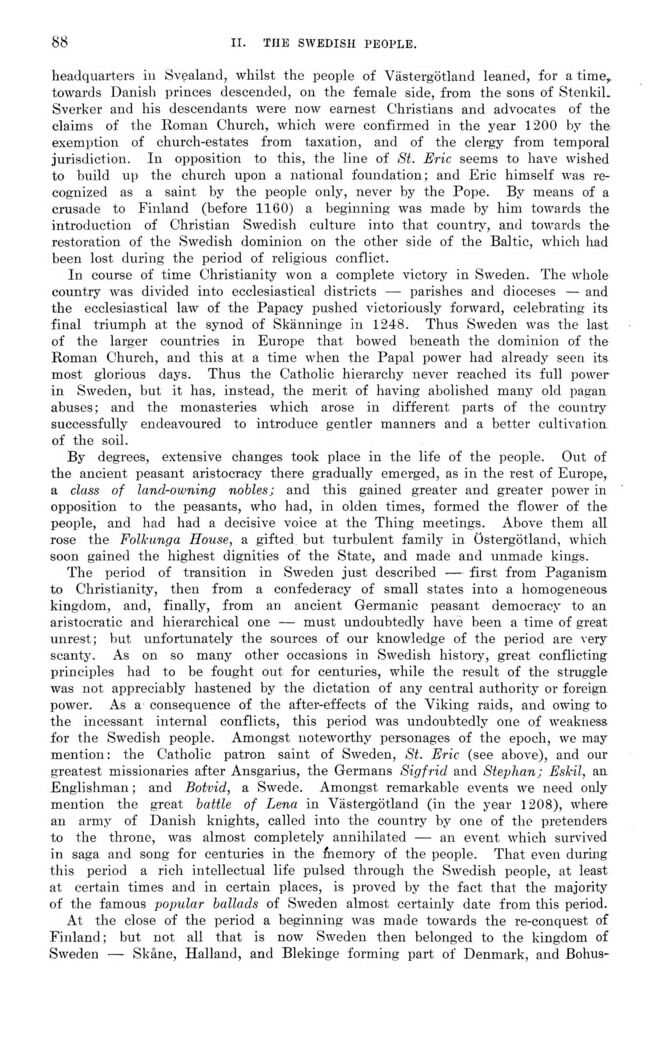
Full resolution (JPEG) - On this page / på denna sida - II. The Swedish People - 1. Survey of its History. By E. Svensén

<< prev. page << föreg. sida << >> nästa sida >> next page >>
Below is the raw OCR text
from the above scanned image.
Do you see an error? Proofread the page now!
Här nedan syns maskintolkade texten från faksimilbilden ovan.
Ser du något fel? Korrekturläs sidan nu!
This page has never been proofread. / Denna sida har aldrig korrekturlästs.
88
II. TIIB SWEDISH PEOPLE.
headquarters in Svealand, whilst the people of Västergötland leaned, for a time,,
towards Danish princes descended, on the female side, from the sons of Stenkil.
Sverker and his descendants were now earnest Christians and advocates of the
claims of the Roman Church, which were confirmed in the year 1200 by the
exemption of church-estates from taxation, and of the clergy from temporal
jurisdiction. In opposition to this, the line of St. Erie seems to have wished
to build up the church upon a national foundation; and Erie himself was
recognized as a saint by the people only, never by the Pope. By means of a
crusade to Finland (before 1160) a beginning was made by him towards the
introduction of Christian Swedish culture into that country, and towards the
restoration of the Swedish dominion on the other side of the Baltic, which had
been lost during the period of religious conflict.
In course of time Christianity won a complete victory in Sweden. The whole
country was divided into ecclesiastical districts — parishes and dioceses — and
the ecclesiastical law of the Papacy pushed victoriously forward, celebrating its
final triumph at the synod of Skänninge in 1248. Thus Sweden was the last
of the larger countries in Europe that bowed beneath the dominion of the
Roman Church, and this at a time when the Papal power had already seen its
most glorious days. Thus the Catholic hierarchy never reached its full power
in Sweden, but it has, instead, the merit of having abolished many old pagan
abuses; and the monasteries which arose in different parts of the country
successfully endeavoured to introduce gentler manners and a better cultivation
of the soil.
By degrees, extensive changes took place in the life of the people. Out of
the ancient peasant aristocracy there gradually emerged, as in the rest of Europe,
a class of lancl-owning nobles; and this gained greater and greater power in
opposition to the peasants, who had, in olden times, formed the flower of the
people, and had had a decisive voice at the Thing meetings. Above them all
rose the Folkunga House, a gifted but turbulent family in Östergötland, which
soon gained the highest dignities of the State, and made and unmade kings.
The period of transition in Sweden just described — first from Paganism
to Christianity, then from a confederacy of small states into a homogeneous
kingdom, and, finally, from an ancient Germanic peasant democracy to an
aristocratic and hierarchical one — must undoubtedly have been a time of great
unrest; but unfortunately the sources of our knowledge of the period are very
scanty. As on so many other occasions in Swedish history, great conflicting
principles had to be fought out for centuries, while the residt of the struggle
was not appreciably hastened by the dictation of any central authority or foreign
power. As a consequence of the after-effects of the Viking raids, and owing to
the incessant internal conflicts, this period was undoubtedly one of weakness
for the Swedish people. Amongst noteworthy personages of the epoch, we may
mention: the Catholic patron saint of Sweden, St. Erie (see above), and our
greatest missionaries after Ansgarius, the Germans Sigfrid and Stephan; Eskil, an
Englishman; and Botvid, a Swede. Amongst remarkable events we need only
mention the great battle of Lena in Västergötland (in the year 1208), where
an army of Danish knights, called into the country by one of the pretenders
to the throne, was almost completely annihilated — an event which survived
in saga and song for centuries in the fnemory of the people. That even during
this period a rich intellectual life pulsed through the Swedish people, at least
at certain times and in certain places, is proved by the fact that the majority
of the famous popular ballads of Sweden almost certainly date from this period.
At the close of the period a beginning was made towards the re-conquest of
Finland; but not all that is now Sweden then belonged to the kingdom of
Sweden — Skåne, Halland, and Blekinge forming part of Denmark, and Bohus-
<< prev. page << föreg. sida << >> nästa sida >> next page >>